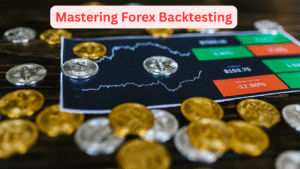 📈 Mastering Forex Backtesting: A Trader’s Guide to Smarter Strategies
📈 Mastering Forex Backtesting: A Trader’s Guide to Smarter Strategies
In the fast-paced world of forex trading, success hinges on more than just intuition or luck. Traders who consistently win are those who rely on data, discipline, and rigorous testing. One of the most powerful tools in a trader’s arsenal is forex backtesting—a method that allows you to simulate your trading strategy using historical data to see how it would have performed in the past.
Whether you’re a beginner trying to validate a new idea or a seasoned trader refining your edge, backtesting is the bridge between theory and real-world performance. In this guide, we’ll explore what forex backtesting is, how it works, why it matters, and how to do it effectively.
🔍 What Is Forex Backtesting?
Forex backtesting is the process of applying a trading strategy to historical currency price data to evaluate its effectiveness. By simulating trades based on past market conditions, traders can assess how a strategy would have performed—without risking any real money.
For example, if you have a strategy that buys EUR/USD when the 50-day moving average crosses above the 200-day moving average, you can backtest this rule on historical EUR/USD data to see how many trades it would have triggered, how profitable they were, and how much drawdown occurred.
🧠 Why Is Backtesting Important?
Backtesting offers several key benefits:
- ✅ Risk-Free Evaluation: Test strategies without financial exposure.
- 📊 Performance Metrics: Analyze win rate, average return, drawdown, and more.
- 🔧 Strategy Optimization: Tweak parameters to improve results.
- 💡 Confidence Building: Trust your system before going live.
- 🚫 Avoid Overtrading: Helps eliminate emotional decision-making.
Without backtesting, you’re essentially flying blind. It’s like launching a product without market research—you might get lucky, but chances are you’ll crash.
🛠️ How to Backtest a Forex Strategy
Here’s a step-by-step guide to backtesting your forex strategy:
1. Define Your Strategy
Start with clear, rule-based criteria. For example:
- Entry: Buy when RSI drops below 30 and then crosses back above.
- Exit: Sell when RSI crosses above 70.
- Stop-loss: 50 pips
- Take-profit: 100 pips
The more specific your rules, the more accurate your backtest.
2. Choose Historical Data
Use high-quality historical data for the currency pair you want to test. Most platforms offer data going back several years. For more accurate results, use tick or minute-level data instead of daily candles.
3. Select a Backtesting Method
- 🖱️ Manual Backtesting: Use platforms like TradingView to scroll through charts and log trades by hand.
- 🤖 Automated Backtesting: Use software like Forex Tester, MetaTrader 4/5, or TradeZella to simulate trades automatically.
4. Run the Simulation
Apply your strategy to the data and record each trade’s outcome. Track metrics like:
- Total number of trades
- Win/loss ratio
- Average profit/loss
- Maximum drawdown
- Profit factor
5. Analyze and Optimize
Look for patterns. Are there certain times or conditions where your strategy performs better or worse? Adjust your parameters and re-test to improve performance.
💡 Real-World Example
Let’s say you’re testing a simple moving average crossover strategy on GBP/USD:
- Buy when the 20-day MA crosses above the 50-day MA
- Sell when the 20-day MA crosses below the 50-day MA
You backtest this over the past 5 years using daily data. The results:
- Total trades: 120
- Win rate: 55%
- Average profit per trade: 35 pips
- Max drawdown: 8%
- Net profit: +1,200 pips
This gives you a solid foundation to either go live or refine the strategy further.
🧰 Best Tools for Forex Backtesting
Here are some popular tools to streamline your backtesting process:
| Tool | Features | Best For |
|---|---|---|
| Forex Tester | Tick-by-tick simulation, manual & automated testing | Intermediate to advanced |
| TradingView | Manual backtesting with bar replay and indicators | Beginners & visual traders |
| MetaTrader 4/5 | Strategy Tester for automated backtesting with Expert Advisors (EAs) | Coders & algo traders |
| TradeZella | Combines backtesting with journaling and analytics | Data-driven traders |
| Traders Casa | Free platform with trade journaling and backtesting tools | Budget-conscious traders |
⚠️ Common Pitfalls to Avoid
- ❌ Overfitting: Don’t tailor your strategy too closely to past data—it may fail in live markets.
- ❌ Ignoring Slippage/Spread: Real trading includes costs that can eat into profits.
- ❌ Cherry-Picking Data: Always test across different market conditions (trending, ranging, volatile).
- ❌ Lack of Sample Size: A strategy that worked for 10 trades isn’t statistically reliable.
📌 Forex Backtesting: Final Thoughts
Forex backtesting is not just a technical exercise—it’s a mindset. It teaches discipline, patience, and objectivity. By rigorously testing your strategies before going live, you dramatically increase your chances of long-term success.
Remember: past performance doesn’t guarantee future results, but it’s a whole lot better than guessing.
❓ FAQs: Forex Backtesting
Q1: Is backtesting 100% accurate?
No, it simulates past performance but can’t predict future market behavior perfectly.
Q2: How much historical data should I use?
At least 3–5 years is recommended for meaningful results.
Q3: Can I backtest without coding?
Yes! Tools like TradingView and Forex Tester allow manual backtesting with no coding required.
Q4: What’s the difference between manual and automated backtesting?
Manual involves visually testing on charts; automated uses software to simulate trades.
Q5: Is backtesting useful for day trading?
Absolutely—especially with minute or tick-level data for intraday strategies.
